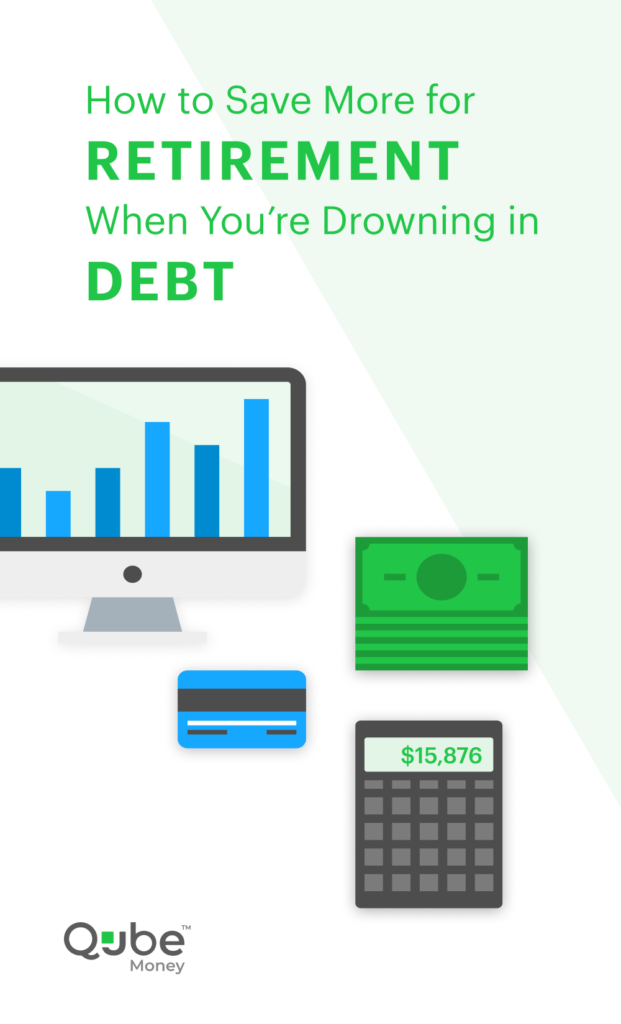If you’re drowning in debt, it’s difficult to save for retirement.
In fact, you may think that retirement allocations should be low on your list of priorities. However, this is the most important time to consider your options and start contributing.
Regardless of where you are on your debt journey, consider your future and the savings associated with it.
Even small contributions toward retirement will make a difference when you reach your golden years. You should always put away at least a minimal portion of your salary for retirement.
Related: How to Eliminate Debt Without Changing Your Lifestyle
Below you’ll find concrete methods to help save for retirement even if you’re drowning in debt. With some focus and will power, you can achieve paying off your owed balances as well as preparing for your golden years.
Take a Deep Breath
Feeling like you’re drowning in debt can cause a lot of stress and frustration. So, before you do anything, take a deep breath.
A lot of times, our debt burden is like a dark cloud that follows us around. It’s easy to get so caught up in our financial stress that we neglect our basic needs.
While you make a plan to repay your debt and get your retirement savings on track, make sure you take care of yourself in the process.
Try avoiding unhealthy ways of coping such as overeating or drinking too much alcohol. It’s crucial that you’re in good health mentally and physically so you can take control of your finances and pay off your debt once and for all.
Related: How Debt is More Than A Financial Concern
Make a Budget
Now that you feel calm, it’s time to create a budget.
Before you can start saving for retirement, it’s important to understand what funds you have coming in and going out.
Begin by creating a spreadsheet of your income and expenses. You may want to break your expenses up into variable and fixed expenses. You may also want to place all of your expenses into categories so you can see where you’re spending your money.
A good rule of thumb is to model your budget after the 50/30/20 rule.
With this rule you want to aim to spend 50% of your income on necessary expenses like housing costs, 20% on savings and investing, and 30% on things you want such as going out to dinner.
If your budget doesn’t fall within these parameters you may want to find areas where you can begin cutting back on some of your expenses.
For example, you may find you’re spending $300 on subscription services but only using Netflix. Start canceling some of these services.
What’s the point of paying for a service if you’re not using it?
Use a budgeting tool like Qube to help you create positive spending habits.
With Qube Money, you create digital envelopes for each category of your budget. You then create a designated amount you can spend with each envelope.
Once you have spent the funds in a specific category, you won’t be able to spend any more money there. Using a tool like Qube Money can help you stick to a budget and not overspend.
Related: You Need A Budget. 6 Reasons to Start Today
By making a budget, you’re telling your money where to go. This can help you prioritize saving for retirement while paying off your debt.
Start Saving for Retirement
Even if you’re drowning in debt, it’s important to start saving for retirement.
The sooner you start contributing to a retirement savings account, the more time your money will have to grow.
So, no matter how much you can contribute to your retirement savings, it’s important to begin today. Even if you’re on a tight budget, you can start saving today.
For starters, you may want to invest in your company’s 401(k).
If your employer offers a matching 401(k) plan, you can contribute and start taking advantage of the free money for your retirement savings. With a 401(k) match program, a company will match your contribution to your account up to a certain amount.
For example, a company may choose to match up to 5% of your total contribution amount. Thus, if you contribute 5%, your company will contribute 5% as well.
Essentially, you’ll double your contributions even before interest or tax advantages. Even if you only contribute 2.5% of your salary, you’re still receiving a large chunk of change that you shouldn’t pass up.
If your company doesn’t offer a 401(k) plan, you should consider opening an IRA or a Roth IRA.
While these accounts don’t offer a match, they still have tax advantages and the opportunity to earn interest on your contributions. To discover which IRA account is most suitable for your financial needs, you can visit IRS.gov for more details.
Tackle High-Interest Rate Debt
If have high-interest rate debt, particularly north of 9%, prioritize these accounts.
You may want to start with a debt repayment method such as the snowball method.
This method incorporates all of your debt balances by helping you repay your smaller revolving debt balance first.
However, in this case, you may want to consider starting with your high-interest balance first. Therefore, if you have a few high-interest rate debt accounts, make a list of each account balance and their interest rates.
Then, you can arrange them by the smallest balance first.
Once you have identified the lowest balance, you can prioritize this account. You’ll do this by continuing to make the minimum payments on all other revolving debt balances while putting any extra cash toward your smallest balance.
After your smallest balance has been repaid you can move on to the next smallest balance, and so on. You’ll continue this pattern until all of your debt is repaid.
Read: Pay It Off – 7 Strategies to Get Out of Debt
According to the Kellogg School of Management, consumers who tackle small balances first are more likely to eliminate debt completely.
This is because consumers feel motivated by their small wins. While this method can work on all sorts of debt, it may be best to still prioritize your high-interest debt balances first to save money on interest.
Contribute to An Emergency Fund
Once you get a handle on your high-interest rate debt, you may want to begin to create an emergency savings fund.
Even if you can only set aside a couple hundred dollars in the beginning, contributing to an emergency fund can help you pay for unexpected expenses.
Financial experts recommend having three to six months of your expenses set aside in case a financial emergency occurs. For instance, if you have to pay for car repairs due to an accident or your home needs a new furnace, you’ll save yourself from having to put these transactions on a credit card.
Not only will you avoid incurring interest but you’ll feel at peace knowing you have the funds to pay for an emergency expense.
Pay Off Lower-Interest Debt
After you have an emergency fund underway and have tackled your high-interest rate debt, you may want to shift your focus to your low-interest rate balances such as your student loans.
If you have multiple student loan balances, consider focusing on one balance at a time. You can choose the smallest balance or the one with the highest interest rate, whichever works best for you and helps you stay motivated.
Remember, you should continue to make timely payments on all accounts even if you prioritize your high-interest rate debt first.
Don’t let your lower interest rate accounts slip into delinquency (even if you’re drowning in debt).
Additional Tips for Boosting Your Retirement Savings While While Drowning In Debt
While tackling all of the larger debt management goals may seem daunting and time-consuming, there are a few other ways you can boost your retirement savings, with smaller, incremental tactics.
Although some of these efforts won’t feel as giant as the ones we mentioned previously, remember that every step forward in the right direction is progress.
Try incorporating these tools to increase your retirement savings on a daily or monthly basis. After a few months, you’ll see the fruits of your labor, and appreciate the effort you made to increase your savings.
Establish goals
Establishing a set of concrete goals will help you keep your eye on the prize.
Write your goals down and put them in a place that you’ll reference often. Consider hanging them by your bathroom sink or on your refrigerator. Don’t be afraid to reevaluate or change your goals. Life is what happens when we’re making plans.
Shifting gears is a natural progression and one that you should embrace.
Read: How to Set and Achieve Financial Goals
Automate your contributions
Automating your contributions is an easy and painless way to assure your allocations are making it to the accounts you intend them to.
You won’t have to think about distributing your monthly income, it will happen automatically. More than likely, you won’t even miss the money that you have on automatic contributions.
Review your finances regularly
The easiest way to get off track from your financial plan is by easing into patterns and neglecting to be vigilant about the goals you have in place.
Establish a budget and revisit it regularly. This will help you spot ways you can improve your fiscal habits, and assist you in staying on track toward achieving your goals.
Increase your contribution by 1%
It’s easy to think that a 1% increase will not make a difference, but this thought process couldn’t be more wrong.
A 1% increase in your contributions will guarantee that you’re putting away more than you were before. If every year you increase your contribution allocation by 1%, you’ll ensure that you’re continuing to prioritize and grow your savings.
Start a side hustle
You work hard, but do you work smart?
While you’re committed to the Monday-Friday, 8-5 workweek, remember that outside of those time frames, you have a few extra hours that you can generate an additional income.
Perhaps you have a hobby or skill that you can monetize or a hidden talent that will assist you in earning an additional income.
Consider incorporating a side hustle into your weekly routine to help grow your allocations and increase your retirement savings over time.
Ask for a raise
It’s important that you speak up for what you work hard for.
If you’re due for a raise, don’t hesitate to approach your management team and begin the conversation. It’s always easier to ask for forgiveness than to ask for permission.
More than likely, and if you’ve put in the work, your team will recognize your efforts and reward them.
The Bottom Line
If you feel like you’re drowning in debt, don’t worry. By making a plan and utilizing retirement savings vehicles you can begin establishing financial security.
Don’t allow the overwhelming nature of your ever-growing responsibilities to force you into retreat mode.
Be aggressive and vigilant in your pursuit of financial security, and take steps toward better providing for yourself.
Financial health and the many steps taken to achieve it can be intimidating. However, if you put a plan in place and enlist the help of individuals who can assist you, you’ll assure you’re on the path toward success.
Finally, don’t forget that missteps are a natural part of the journey.
It’s not as important if you make mistakes, but rather how you recover from them. Take each step in stride, and use it as a lesson learned.
Remember that the most important thing you can do today is to take steps toward providing for yourself tomorrow.
Prioritize your financial health, retirement savings, and debt repayment to assure you’re taking the best care of your future that you can even if today you’re drowning in debt.




